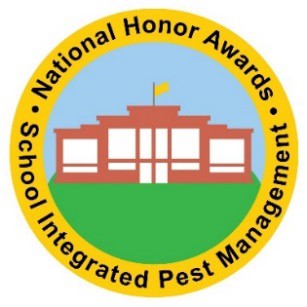Connector or National Change Agency Award
School Integrated Pest Management Awards Program
Final Attachment F - School IPM Application Guide and Forms_rev2017-03-24
Connector or National Change Agency Award
OMB: 2070-0200
OMB Control No.: 2070-XXXX.
Expiration Date: XX/XX/2020.
 SCHOOL
INTEGRATED
PEST
MANAGEMENT
AWARDS
SCHOOL
INTEGRATED
PEST
MANAGEMENT
AWARDS
APPLICATION GUIDE
C O N T E N T S
Sanitation, Exclusion, and Record-Keeping 3
Application Purpose, Burden, Benefits, Confidentiality, and Feedback 3
Criteria for Great Start, Leadership, and Excellence Awards 4
Criteria for Tier 4: Sustained Excellence Award 5
Criteria for Connector Award* 5
The US Environmental Protection Agency wishes to acknowledge school districts, individuals and organizations that protect students and the school community as a whole from pests and pesticides through the adoption of Integrated Pest Management (IPM). In order to recognize and reward these school districts and individuals, the EPA has established five IPM awards.
Tier 1: Great Start Award - Given to school districts that have demonstrated a commitment to implementing IPM [insert link to Great Start application]
Tier 2: Leadership Award - Given to school districts that have taken action to reduce the dangers associated with pests and pesticide use by implementing IPM [insert link to Leadership application]
Tier 3: Excellence Award - Given to school districts that have implemented exemplary IPM programs [insert link to Excellence application]
Tier 4: Sustained Excellence Award - Given to school districts that have been given the Excellence Award in the past and that have demonstrated the continued success and sustainability of their IPM programs [insert link to Sustained Excellence application]
Connector Award - Given to individuals and organizations that have contributed to the adoption and use of IPM policies in school districts at the community, state, region, or national level. [insert link to Change Agent application]
A P PLI C A TIO N TIM E L I N E
Districts may apply for recognition at Tiers 1 and 2 on a year-round basis. Applications for Tier 3, 4 and Connector should be submitted by November 1st. Awardees will be chosen by the following January.
R E P E A T A W A R D S
A district or individual may apply as many times as they would like for the awards. A district may be given any of the awards multiple times, with the exception of the Excellence Award. A district may receive the Excellence Award only once.
I M P O R TAN T N O T E S
C o m p l i a n c e w i t h S t a t e L a w s
To be eligible for an IPM award, a district must be in compliance with state laws, including those regarding pest management. Some states have laws which are more stringent than the guidelines provided in this document. Districts in states with laws which are more stringent than the guidelines in this document must still adhere to state law in order to be eligible to receive an IPM award from the EPA.
L a r g e S c h ool Distr i c t s
The EPA recognizes that implementation of an IPM program may be especially difficult for large school districts. When reviewing a district’s IPM award application, the EPA will consider the number of students and facilities in that district. Large districts which have IPM pilot programs at one or several facilities may receive awards. Large school districts with pilot programs should explain in their applications the number of facilities in which the pilot program is being implemented.
S a n itat ion , E x c lus ion , a n d R e c o r d - K e e p i n g
While the criteria for the Great Start Award do not include sanitation, exclusion, or record-keeping requirements, the EPA is not implying that these aspects of IPM are not important. In fact, good sanitation, sealing of holes and cracks in buildings, and record-keeping can have benefits that extend beyond IPM, such as lower energy bills and more effective use of staff time.
A p p l ica t i o n P u rpo s e, B u rden, B e n e f i t s , C o n f ide n t i a lity, a n d F e e dba c k
The School Integrated Pest Management Awards program is designed to recognize school districts that are in various stages of implementing successful IPM practices. The awards program consists of five tiers related to various levels of achievement. Applicants will complete one of five applications based on where they are in the process of IPM implementation. Information obtained from these applications will be used to showcase school IPM best practices to encourage replication and adoption of IPM strategies in school districts across the nation. EPA promotes the integration of school IPM practices as an environmentally friendly, common sense approach to controlling pests and published a Strategic Plan for School IPM to further solidify its commitment to comprehensive environmental health in schools.
The application process is simple. EPA provides guiding questions to assist the applicant in communicating details about their program plan for school IPM practices. All responses are voluntary; however without details about a district’s school IPM program, applicants cannot be evaluated against the criteria for each award tier. For the short answer questions on the application, a word limit will be imposed to lessen the burden for the applicant. This will require applicants to be succinct with their responses to properly convey their district’s actions and commitment to school IPM. Burden estimates for applying for each award are provided on the specific award applications.
All applicants chosen for an award will receive the benefit of public recognition for their efforts dedicated to school IPM. This can occur in a press release, social media posting or other public outreach methods the school district wants to pursue. As an outcome from this award selection process, EPA would continue to showcase these school districts as model programs for successfully executing comprehensive IPM practices. EPA may request, on occasion, that personnel from these districts participate as case study speakers on webinars or at conference venues. These districts can be mentors for other districts just beginning school IPM programs or those reinvigorating their plans. EPA would foster these connections.
Confidentiality of the information provided on these applications will be the standard operating procedure for managing the awards process. EPA will include a disclaimer on the web page housing the awards information and on the awards package itself – reiterating our goal to not share contact information with outside sources unless permission is granted by the applicant. If any questions arise concerning the application process or the burden incurred, applicants should contact school.ipm@epa.gov.
C RIT E RIA F O R GREA T S T ART, L E A D E R S H I P, AND E X C E L L E N C E A W A R D S
In order to receive recognition at Tier 2 or 3, a district must fulfill all of the criteria for that award as well as the criteria for all lower-tiered awards.
-
Tier 1: Great Start
Tier 2: Leadership
Tier 3: Excellence
Laws
Must meet all applicable state or tribal laws
Must meet all applicable state or tribal laws
Must meet all applicable state or tribal laws
Previous Recognition / Miscellaneous
School districts with existing third-party certification may qualify and/or credit may be given for other IPM activities.
Organizational Support
The pest management professional and school administration are informed of the decisions and actions of the IPM Committee. The committee and the pest management professional follow the IPM plan.
Written Statements
Written IPM plan including pest thresholds
IPM plan is updated annually
Education
IPM education for custodial, maintenance, groundskeeper,
kitchen, and nurse staff
IPM education for staff, including teachers and coaches, with certificates awarded
Assessment
Self-assessment using checklist
Monthly inspection of pest vulnerable areas (including insect and rodent stations)
Full inspection of all facilities (annually)
Record-keeping
Pesticide Safety
Sanitation
Appropriate food storage, kitchen sanitation, rooms free of clutter
Exclusion
Grounds / Outdoor
C RIT E RIA F O R T I ER 4 : S U STA I N E D E X CEL L E NCE A W A R D
To qualify for Tier 4 recognition, a district must:
demonstrate that it continues to meet all Tier 3 criteria for at least two years after receiving Tier 3 recognition.
provide documentation of its strategy and efforts to make its IPM program sustainable.
provide documentation of program results in terms of pest reduction, health improvements, and financial benefits. Note that this does not mean the district must meet some quantified level of results
– this is more about making sure that the district is documenting its program’s results than making sure the programs are achieving some set level of success.
demonstrate how it has been communicating about its IPM program, both to its internal community (students, parents, employees) and to the external community (other districts, educational associations).
As many third-party certifications require recertification, repeated recognition can provide evidence that a district continues to meet all Tier 3 criteria. However, districts that receive repeated third-party recognition must also meet the other Tier 4 criteria (demonstrating sustainability, results, and communication).
C RIT E RIA F O R CON N E C TOR AWA R D *
The Connector award is an award for individuals and organizations that have contributed to the adoption and use of IPM policies in school districts at the community, state, region, or national level.
Connector awardees must:
demonstrate actions and initiatives that support school IPM.
provide a detailed account of their actions contributing to school IPM, including documentation of the results of their actions (what these results would be depends on the specific actions taken).
describe how they communicated with school districts (if working at higher or lower tiers, this could instead be state boards of education or individual schools) to facilitate their IPM efforts.
demonstrate how the achievements made by their actions will be sustained in the future.
have at least one endorsement from a relevant entity (school, school district, state board, etc.) in order to verify the significance of their contribution.
D E F I N I T I O N S A N D CLA R I F I C A TIO N O F TER M S
O r g a niz a t i o n a l S uppor t
IPM Coordinator
There must be someone at the facility who coordinates pest control activities. This person might:
Interact with a pest control professional before, during or after their visit
Keep records of complaints, monitoring and applications
Be familiar with pest threats and pressures; as well as pest vulnerable areas (PVAs) of the facility
Decide when and where pesticides will be applied
It doesn’t matter what exactly their role in pest management is, but rather that there is someone in-house who is taking or wants to take ownership of the facility’s pest management program.
IPM Committee or Environmental Health Committee
This group should be made up of the IPM coordinator, the school nurse, and at least one person from each of the following groups: teachers, custodial/maintenance staff, students, and parents. The committee’s responsibilities include providing guidance, education, and support on program procedures and processes.
The district leadership will appoint the members of this committee. The committee should meet at least semi- annually.
W rit t e n D o c u m e n t s
IPM policy
This written document includes the following components:
Prevention (sanitation, exclusion, routine inspections, etc.)
Regular monitoring
Preference for least-risk pesticides and application methods
Record keeping (monitoring, applications, work orders, etc.)
Pesticides used only when needed (someone makes a calculated decision to apply or not)
Protecting children or reducing health hazards associated with pests and pesticides
A sample IPM policy can be found at https://www.epa.gov/managing-pests-schools/integrated-pest- management-tools-resources-support-ipm-implementation#model policy.
IPM plan
An IPM plan addresses and details the components of the district policy, lists approved low hazard/toxicity products and methods by pest, and discusses the decision-making process for any pest mitigation effort, to include methods for monitoring, reporting pest sightings, action levels for the use of pesticides and a list of all environmentally sensitive areas that may be impacted by the district’s pest management activities. The IPM coordinator develops and submits a recommended pesticide safety and IPM plan to the IPM committee for review and comment. The IPM coordinator submits a final draft, which addresses committee comments, to the district leadership for submission to the board. Pests are listed in order of medical or health risk importance to assist in prioritizing pest mitigation efforts based on risk to students, staff and the community. The IPM coordinator, in coordination with the designated district school nurse, develops and includes appropriate action steps in the program plan for each pest of public health importance deemed a probable risk by the committee (head lice, bed bugs, fire ants, etc.). A sample IPM Plan can be found at http://cals.arizona.edu/apmc/docs/az1669-08-03-15.pdf.
Difference between policy and plan
An IPM policy sets out a district’s IPM goals and requirements; an IPM plan determines actions that ensure that the goals and requirements set out in the policy will be met.
E duca t i o n
The IPM coordinator should be trained in the principles of Integrated Pest Management and pest control contract oversight, completing a minimum of six (6) to eight (8) contact hours of training annually on the subject.
Custodial and food service staff should be trained a minimum of one (1) hour annually on the components of IPM and how their efforts towards sanitation impact pest infestations.
Facilities management personnel should be trained a minimum of one (1) hour annually on the components of IPM and how their efforts at sealing the building envelope and repairing water leaks impact pest infestations.
Teachers and administrative staff should be trained a minimum of one (1) hour annually on the components of IPM and how their efforts for clutter removal and general classroom/office sanitation impact pest infestations.
Students and the general public should be provided direct and supplemental education/information on the district’s program, and how they contribute to success of the program.
All personnel should be trained on how to identify and report pest problems and conditions that lead to pest infestations.
A s s e s s m ent
Checklist
The IPM coordinator walks through the district’s facilities and fills out an IPM self-assessment checklist. A self- assessment checklist can be found at http://ischoolpestmanager.org/docs/328.0.pdf.
Routine inspections
The purpose of routine inspections is to prevent new infestations, identify emerging ones, and evaluate current pest management practices. A trained staff or professional should be looking for pest evidence, access points, sources of food and water, harborage sites, and pest populations at least monthly in pest vulnerable areas, such as: kitchens, food storage areas, cafeterias, custodial closets, teachers’ lounge, exterior areas, and dumpster areas.i Routine visits from a pest control company may or may not include this type of proactive inspection. Reporting that, “yes, they are done by the pest guy”, is not sufficient. Replacing baits or traps is not considered “routine inspections” in this instance. Checking monitoring stations, assessing pest- conducive conditions and identifying emerging problems would be considered “routine inspections.”
Insect or rodent stations
Monitoring stations or traps should be in kitchens, food storage areas, cafeterias, custodial closets, and other PVAs. Monitoring stations may include insect sticky traps, rodent traps or nontoxic detection blocks. The facility must have signs of an active monitoring program (traps in PVAs) and a log of findings.ii Ensure that monitor traps have dates and that the pests observed in the traps are properly identified and that records are kept of where monitor stations are placed. Traps and monitoring stations should be inaccessible to children.
Full inspection
Districts should do a thorough inspection of facilities for evidence of pests, pest-conducive conditions, and pesticide danger (improper storage, improper labeling, etc.) annually. The inspection should be performed by the IPM Coordinator, accompanied by another member of the IPM committee. If the district has contracted any pest management services to an outside company, the outside pest manager should accompany the IPM Coordinator during the inspection. It is ideal, however, that thorough inspections be conducted quarterly because each season of the year can present unique pest issues.
R e c o rd- k e e p i n g
Pesticide use records
Pesticide use records need to include all of the following:
Name of applicator
Pesticide used with EPA registration number, label rate and amount applied (with copy of label)iii
Targeted pest
Location treated
Date and time of application
Application method
States and tribes vary on how long records must be retained. Facilities should maintain records for at least a year, if not longer, in order to determine trends and identify problem areas. The IPM Institute of North America recommends retaining records for a minimum of three years.iv
Monitoring records
The findings from each monthly inspection should be recorded. The dates that traps and insect/rodent stations are placed and replaced should be recorded.
Pest sighting or complaint logs
A simple tracking device or system is in place for building occupants (staff, parents, teachers, students) to note where and when they see a pest.v Sometimes you may see these logs posted in bathrooms and other pest vulnerable areas, other times you’ll need to ask directly whether there are logs in place.
Maintenance records
The IPM coordinator or facility manager should keep records of all pest-related maintenance requests and maintenance operations.
P e s t i c i d e S a f e t y
Posting
Pesticide application sites are posted with highly visible signage during and at least 24-48 hours after all pesticide applications. Postings are labeled with the date of application, pest treated for, pesticide used, applicator name, certification number of applicator, phone number of applicator/company, and date/time reentry is authorized. For emergency applications where an imminent threat to health exists (e.g., stinging insects), postings must be placed as soon as practical, with a preference to no later than the start of the pesticide application.
Notification
Students, staff and parents/guardians are notified at least 24-48 hours prior to any pesticide application. For emergency applications where an imminent threat to health exists (e.g., stinging insects), students, staff, and parents/guardians will be notified within 24 hours after the pesticide application.
Posting and notification exemption
The use of insecticide or rodenticide baits in pre-manufactured, tamper-resistant containers placed in areas inaccessible to children, insecticide baits in gel or paste form placed in cracks and crevices inaccessible to children, and antimicrobial pesticides, including sanitizers and disinfectants, are exempt from notification, posting and exclusion requirements unless specified otherwise on label directions. Rodenticide baits in tamper-proof containers are exempt from exclusion requirements, but must be labeled with all other posting requirements on the exterior of each container. Such containers should be limited to areas normally inaccessible to children.
Pesticides stored safely
All pesticide products should be in a locked room or cabinet, away from food storage and preparation areas, and accessible only to authorized staff. All pesticide products should be stored in original containers with labels.vi
Certified pesticide applicators
Only state or tribe certified pesticide applicators trained in Integrated Pest Management apply pesticides on School District properties.
Guidelines for pesticide selection and application
When reasonable non-chemical approaches do not provide adequate control, products that pose the least risk to people and the environment are to be selected, and then only used when and where pests are present, or expected to be present, as determined by monitoring and action thresholds and approved by the IPM coordinator. Pesticide applications are not made on a routine or regularly scheduled basis. The use of pesticides with the signal words ‘Warning’ and ‘Danger’ should be avoided. In documented emergency situations where the presence of a pest immediately threatens the health or safety of students, staff, faculty members or members of the public using the campus, the IPM coordinator may consider the use of pesticide products that do not fit the above criteria.
Pesticides must not be applied when persons, other than pesticide applicators, are present or are expected to be present. All persons other than the pesticide applicators must be excluded from the treated site for at least eight (8) hours after the completion of any pesticide application, or as prescribed by the pesticide label, whichever is longer.
S a n itat ion
Trash areas well maintained, clean and contained
Trash cans and dumpsters should be in good condition (without holes), clean (without waste buildup) and have tight fitting lids (in use) to restrict pest access and attraction to garbage areas. Trash should not be flowing out or spilling over the container. The area around trash cans and dumpsters should also be clean- free of waste and spills.vii
Dumpster(s) located 50 ft. from facility
Dumpster(s) located at least 50 ft. from the facility attract pests away from the building, where they are less likely to cause damage and get indoors.viii
Appropriate food storage
Refrigerators and freezers should be tightly sealed, clean and organized to mitigate pest access and attraction. Dried and canned foods should be removed from cardboard boxes and stored on shelves at least six inches off the ground.ix Cardboard boxes should be mostly broken down and recycled. Dry goods such as flour, sugar, beans, cereals, etc. should be stored in pest resistant containers with snap-tight or screw-top lids. All shelving should be made of non-absorbent material and easy to move for routine cleaning.
Good sanitation in kitchen, cafeteria, and food storage areas
Kitchens, cafeterias, other eating areas (offices, classrooms, concession stands) and food storage areas should be free of food crumbs, spills, grease buildup and other organic debris in and under appliances, equipment, corners, cabinets, and drains (floor and sink). All areas should be cleaned thoroughly, at least daily.
Rooms free of food debris and/or clutter
Non-food areas should be mostly free of food debris and clutter, including excess or unused equipment. Rooms that should be considered include classrooms, locker areas, storage areas, and lounge areas. Art supplies and food-related materials are in sealed clear containers to keep out pests. Storage cabinets are organized and searchable. Students’ lockers/cubby spaces are clean and monitored regularly for possible pests.
E x c l u sion
Door sweeps
Door sweeps must be installed on exterior doors. The door sweeps must have dense bristles and installed in such manner that no holes for pest entry are visible.
Structure free of gaps, holes and other entry points
The exterior of the facility should be mostly free of entry points that allow pests access to the structure.x If you can see light through gaps and holes, there is enough space to allow arthropods (insects, arachnids and crustaceans) access; rodents require a larger space-anywhere between ¼ to ½ inch, depending on the species.xi Entry points might include: gaps around doors, windows and wall penetrations (including unsealed gaps around utility entryways); cracks in the foundation and walls; missing or torn screens on vents, doors and windows; crawl space doors/entrances; gaps and missing panels around roof top vents and HVAC systems; roof eaves; and propped open doors. If you are unsure whether a space can provide access, use your pen or pencil to see if it can pass through. If so, a rodent, insect or spider could get in that way.
G r oun d s / Out d oor s
Visibility between landscaping and facility
The exterior of the facility should be mostly free of excessive, thick, brushy or weedy vegetation to increase visibility and to minimize pest attraction and access to the structure. Vegetation including ivy, shrubs, and branches should not be in contact with the structure. There should also not be excessive soil, grass, mulch or stones next to the structure. Grass next to the building should not exceed a height of more than 12 inches.xii You should be able to see the building foundation to inspect for pests.
Exterior free of clutter and harborage
The exterior of the facility should be mostly free of clutter and harborage.xiii Harborage is any condition that provides a shelter or breeding area for pests. Examples: wood piles, food debris and yard waste (leaves, rotting fruit, and branches), standing water, equipment stored outdoors including kitchen appliances, furniture, landscaping and maintenance tools, and construction materials.

i Gouge, Baldwin, Oi, & Schmeits, IPM in Schools/Child Care Pest Monitoring Protocol, Apr 2007, http://www.extension.org/mediawiki/files/7/78/schoolipm_pest_monitoring_protocol_4.3.pdf
ii Gouge, Baldwin, Oi, & Schmeits, op. cit.
iii Environmental Protection Agency, Pest Control in the School Environment: Adopting Integrated Pest Management, Aug 1993, http://www.epa.gov/pesticides/ipm/brochure/EPA-735-F-93-012.pdf
iv IPM Institute of North America, IPM Standards, op. cit.
v IPM Institute of North America, School IPM 2015: A Strategic Plan for Integrated Pest Management in Schools in the United States,
July 11, 2011 http://www.ipminstitute.org/school_ipm_2015/SCHOOL_IPM_2015_v2%200_DRAFT_FOR_COMMENT_071111.pdf
vi eXtension’s “School IPM Pesticide Storage Tips”, Feb 2014, http://www.extension.org/pages/20396/school-ipm-pesticide-storage- tips
vii IPM Institute of North America’s “IPM Standards for Schools,” July 2004. http://www.ipminstitute.org/pdf/ISS%20V3.2%20073004.pdf
viii Merchant, Swiger, PMSP, Extension.org, School IPM Action Plan for House Flies and Filth Flies, May 2012, http://www.extension.org/pages/63910/school-ipm-action-plan-for-house-flies-and-filth-flies; Gouge, Lame, Glick, CA Dept of Pesticide Regulation, Integrated Pest Managment- Design Considerations for Schools, 2009, http://apps.cdpr.ca.gov/schoolipm/architects_designers/architectural_guide.pdf;

ix Iowa State Univ, Food Safety Project, https://www.extension.iastate.edu/NR/rdonlyres/071E9D9B-390B-4DDB-9CDD- 34B9105C0E06/63234/SCSOP13PestControl.doc; WSU School IPM “What is IPM?,” 2014, http://schoolipm.wsu.edu/what.html
x 21 CFR 110.20 & 21 CFR 110.35, “The plant and facilities shall provide, where necessary, adequate screening or other protection against pests. Buildings, fixtures, and other physical facilities of the plant shall be maintained in a sanitary condition and shall be kept in repair sufficient to prevent food from becoming adulterated within the meaning of the act. Effective measures shall be taken to exclude pests from the processing areas and to protect against the contamination of food on the premises by pests. “
xi Geiger & Cox, SF Environment, Pest Prevention by Design, Nov 2012, http://www.sfenvironment.org/download/pest-prevention- by-design-guidelines; Green, Graham, & Hurley, Extension.org Pest Proofing and Exclusion Webinar, Sept 2012, https://learn.extension.org/events/587; Stock, Corrigan, Gouge, Oregon State University, Integrated Pest Management of the House Mouse, Apr 2013, http://ir.library.oregonstate.edu/xmlui/bitstream/handle/1957/38106/em9062.pdf; W.H. Kern, Jr. and
Koehler, University of Florida, Mar 1998, http://schoolipm.ifas.ufl.edu/tp9.htm
xii Centers for Disease Control and Prevention. "Integrated pest management: conducting urban rodent surveys. Atlanta: US Department of Health and Human Services; 2006, http://www.cdc.gov/nceh/ehs/docs/ipm_manual.pdf
xiii 21 CFR 110.20 & 21 CFR 110.35, “The grounds under the control of the operator shall be kept in a condition that will protect against the contamination of food. Adequate maintenance of the grounds include, but not limited to: properly storing equipment, removing litter and waste, and cutting weeds or grass within the immediate vicinity of the plant buildings or structures that may constitute an attractant, breeding place, or harborage for pests; and adequately draining areas that may contribute contamination to food by seepage, foot-borne filth, or providing a breeding place for pests.”; University of Florida Extension, Florida School IPM Best Management Practices, Aug 2012, http://schoolipm.ifas.ufl.edu/Florida/Floridaipmbmp2012.pdf
The U.S. Environmental Protection Agency’s (EPA) School Integrated Pest Management (IPM) Great Start Award is presented to school districts that have made a commitment to implement an effective Integrated Pest Management program and that have taken the first steps towards implementing IPM. The Great Start Award is one of five tiers of IPM awards, which the EPA presents to school districts or individuals. To find out which tier of recognition is the best fit for your district, visit [insert website].
Recipients of the School IPM Great Start Award will receive:
A “Great Start in School IPM” certificate signed by an EPA official;
Recognition on EPA’s web site – [insert web site];
Access to topical webinars, trainings, events and recognition and mentoring opportunities;
Regular e-mail updates aimed at advancing your school IPM program.
Eligibility
For a school district to receive the Great Start Award, the district must:
Comply with all state laws;
Only allow pesticides to be applied by a certified pesticide applicator;
Have a designated IPM Coordinator that is receiving regular IPM training;
Have a written IPM Policy;
Complete a self-assessment using an IPM checklist which addresses the pest-conducive conditions and pest problems present in the district.
How to Apply
Interested candidates should complete the attached application and submit the application by e-mail, U.S. Mail, facsimile or special delivery services (Federal Express, United Parcel Services, etc.).
E-mail:
ATTN: school.ipm@epa.gov
U.S. Mail (or Special Delivery):
ATTN: EPA Center of Expertise for School IPM 1445 Ross Avenue (6PD-P)
Dallas, TX 75202
The application is a fill-in form, which will allow you to save what you have filled in on your computer and submit it electronically via e-mail.
Applications for the Great Start Award are accepted year-round on a non-competitive basis. For specific questions, contact the School IPM Awards Coordinator at [insert contact information].
Guidance for Completing the Great Start Application
Clarification of the terms used in the attached application, guidance about how to get started with IPM in your school district, and an IPM self-assessment checklist can be found at [insert website].
School System/District Information
Please provide all of the information requested in the table below. Note: If the contact person for this application is not in school during the summer break, please provide additional contact information (e.g., cell phone, alternate contacts) to allow EPA to contact you if necessary about your application.
The application is a fill-in form, which will allow you to type your answers directly into the form, save what you have filled in on your computer, and submit it electronically via e-mail.
IPM Coordinator Contact Information |
|
School System/District Name: |
|
Name of IPM Coordinator |
|
Title |
|
Department |
|
Address |
|
City, State, Zip Code |
|
Telephone |
|
Fax Number |
|
E-mail Address |
|
School System/District Profile |
|
Total Number of Students |
|
Total Number of Staff |
|
Total Number of Facilities in Your System/District (e.g., 45 schools, 5 educational support buildings) |
|
Age Range of All System/District Facilities (e.g., 5-90 years old) |
|
Total Square Footage (ft2) of All System/District Facilities (e.g., 1.5 million ft2) |
|
Total School District Budget |
|
Number of School Facilities in Your School System/District Participating in the School IPM Program |
|
School System/District Information Statement of Compliance with State Law
I certify that School District is in compliance with the laws of the State of
, including the laws that pertain to pest management and pesticide application.
Signature Print Name Date
Your District’s Integrated Pest Management Program
Coordinator: Who is your district’s Integrated Pest Management Coordinator? When did this person become the IPM coordinator? What is the role the IPM coordinator in managing pests and pest-conducive conditions in your district?

Education: Does your district’s IPM Coordinator receive at least eight (8) hours of training per year in Integrated Pest Management techniques? How or where does the coordinator receive this training?

Policy: Does your district have a written IPM Policy? A sample IPM Policy can be found at [insert link]. Please attach a copy of the written IPM policy to this application.
Self-Assessment: Have you completed a self-assessment using an IPM checklist for some or all of the facilities in your district? An example of a self-assessment checklist can be found at [insert link]. For what portion of the facilities in your district has an IPM self-assessment been completed? Your application will be evaluated on whether you have completed a self-assessment for at least some of the schools in your district, not on the findings of the self-assessment. Please attach a copy of the completed checklist/s to this application.

Certified Applicator: Are all pesticide applications in your district performed by a certified applicator? Please attach proof of certification to this application.
 Narrative:
Please use the space below to detail any aspects of your district’s
Integrated
Pest Management
program which you have not mentioned anywhere else in this
application.
Narrative:
Please use the space below to detail any aspects of your district’s
Integrated
Pest Management
program which you have not mentioned anywhere else in this
application.
Paperwork Reduction Act Notice:
In accordance with 5 CFR 1320.5(b), an agency may not conduct or sponsor a collection of information, and a person is not required to respond, unless it displays a valid OMB control number. The estimated paperwork burden to apply for the Great Start Award is 4 hours per application. The burden estimates include time for reading the instructions, gathering and maintaining information, and completing the form.
Responses to this collection of information are necessary in order to participate in the award program. Send comments regarding the burden estimate or any other aspect of this collection of information, including suggestions for reducing the burden, to the Director, Collection Strategies Division (2822T), U.S. Environmental Protection Agency, Washington, DC 20460; and to OMB, addressed to Desk Officer for EPA, via email to oira_submission@omb.eop.gov. Do not send completed forms to these addresses.
The U.S. Environmental Protection Agency’s (EPA) School Integrated Pest Management (IPM) Leadership Award is presented to schools and/or school districts who make a senior- level commitment to establish and maintain sustainable IPM programs. The Leadership Award is one of five tiers of IPM awards, which the EPA presents to school districts or individuals. To find out which tier is the best fit for your district, visit [insert website].
Recipients of the School IPM Leadership Award will receive:
A “Leadership in School IPM” certificate signed by an EPA official;
Recognition on EPA’s Web site – [insert website];
Access to topical web conference calls, training, events, and recognition and mentoring opportunities; and
Regular e-mail updates aimed at advancing your school IPM program.
Eligibility
For a school district to receive the National Leadership Award, the district must:
Meet all requirements of the Great Start Award, including compliance with all relevant state laws;
Form an Environmental Health/IPM Committee;
Provide IPM education for Custodial, Maintenance, Groundskeeper, Kitchen, and Health staff members;
Have a written IPM Plan in place;
Conduct monthly inspections including insect and rodent monitoring stations;
Provide pesticide use records and monitoring records;
Store pesticides properly and notify the public when they are used;
Maintain trash areas and keep dumpsters at least 50 feet from any school facility;
Use door sweeps;
Manage vegetation near buildings.
How to Apply
Interested candidates should complete the School IPM National Leadership Award application and submit the application by e-mail, U.S. Mail, facsimile or special delivery services (Federal Express, United Parcel Services, etc.). Applications for the Leadership Award are accepted year- round on a non-competitive basis. For specific questions, contact [insert contact information].
The application is a fill-in form, which will allow you to save what you have filled in on your computer and submit it electronically via e-mail.
All applications may be submitted by e-mail, facsimile, U.S. Mail, or special delivery services (Federal Express, United Parcel Services, etc.).
E-mail:
ATTN : school.ipm@epa.gov
U.S. Mail (or Special Delivery):
ATTN: EPA Center of Expertise for School IPM 1445 Ross Avenue (6PD-P)
Dallas, TX 75202
Guidance for Completing the Leadership Application
Clarification of the terms used in the attached application can be found at [insert website].
School or School System/District Information
Please provide all of the information requested in the table below. Note: If the contact person for this application is not in school during the summer break, please provide additional contact information (e.g., cell phone, alternate contacts) to allow EPA to contact you about your application, if necessary.
The application is a fill-in form, which will allow you to type your answers directly into the form, save what you have filled in on your computer, and submit it electronically via e-mail.
IPM Coordinator Contact Information |
|
School System/District Name |
|
Name(s) of IPM Coordinator and IPM Team Members (if necessary, please include an additional sheet listing all IPM Team members) |
|
Title |
|
Department |
|
Address |
|
City, State, Zip Code |
|
Telephone |
|
Fax Number |
|
E-mail Address |
|
School System/District Profile |
|
Total Number of Students |
|
Total Number of Staff |
|
Total Number of Facilities in Your System/District (e.g., 45 schools, 5 educational support buildings) |
|
Age Range of All System/District Facilities (e.g., 5-90 years old) |
|
Total Square Footage (ft2) of All System/District Facilities (e.g., 1.5 million ft2) |
|
Total School District Budget |
|
Number of School Facilities in Your School System/District Participating in the School IPM Program |
|
Please review the statements in each section and check all boxes that apply to your school or school district IPM program.
School System/District Information Statement of Compliance with State Law
I certify that School District is in compliance with the laws of the State of , including the laws that pertain to pest management and pesticide application.
Signature Print Name Date
Your District’s Integrated Pest Management Program
Great Start Award: Has your district previously received the Great Start Award? If so, please state when your district received the award. If not, please briefly explain how your district meets the requirements of the Great Start award (information on the Great Start award can be found on the same website as the information for the Leadership award: [insert website]).

Environmental Health/IPM Committee: Please describe the structure, membership, responsibilities, and activities of your school district’s Environmental Health/IPM Committee.

Staff Education: Please discuss the IPM education your district provides for Custodial, Maintenance, Groundskeeper, Kitchen, and Health staff members. Make sure to note the frequency, duration, and structure of this education. If you have any documents used in this process, please attach them to this application.

IPM Plan: Does your district have a written IPM Policy? A sample IPM Plan can be found at [insert link]. Please attach a copy of your school district’s IPM Plan to this application.
Inspections: Does your district conduct monthly inspections including the use of insect and rodent monitoring stations? Please explain your district’s process for carrying out these inspections. If you have any documents relevant for this item, such as a sample inspection form, please attach them to this application.

Pesticide Use and Monitoring Records: Does your district keep records of pesticide use and of the results of its monthly inspections? Please describe your district’s process for keeping these records and, if your district does so, reviewing and taking action based on the records. Please attach a copy of a pesticide use record used by your district to this application (can be a sample form or an actually used form).

Pesticide Notification and Storage: Does your district follow the recommended procedures for pesticide use notification and pesticide storage? Please describe how your district notifies the public of pesticide use and how pesticides are stored in your district. If you have any supporting documentation, such as a sample notification letter or posting, or photos of your pesticide storage area, please attach it to this application.

Trash Areas and Dumpsters: Does your district meet the requirements for proper maintenance, sanitation, and placement of trash areas and dumpsters? If you would like to provide photos of trash areas and dumpsters in your district, please attach them to this application.

Door Sweeps: Has your district installed door sweeps on exterior doors and are the door sweeps of proper quality? Please mention, if available, the brand of the door sweeps your district uses.

Vegetation near Buildings: What is your district’s policy regarding vegetation near buildings? Does your district meet the given requirements for visibility between structures and vegetation?

Narrative: Please use the space below to detail any aspects of your district’s Integrated Pest Management program which you have not mentioned anywhere else in this application.

Paperwork Reduction Act Notice:
In accordance with 5 CFR 1320.5(b), an agency may not conduct or sponsor a collection of information, and a person is not required to respond, unless it displays a valid OMB control number. The estimated paperwork burden to apply for the Leadership Award is 38 hours per application. The burden estimates include time for reading the instructions, gathering and maintaining information, and completing the form.
Responses to this collection of information are necessary in order to participate in the award program. Send comments regarding the burden estimate or any other aspect of this collection of information, including suggestions for reducing the burden, to the Director, Collection Strategies Division (2822T), U.S. Environmental Protection Agency, Washington, DC 20460; and to OMB, addressed to Desk Officer for EPA, via email to oira_submission@omb.eop.gov. Do not send completed forms to these addresses.
The U.S. Environmental Protection Agency’s (EPA) School Integrated Pest Management (IPM) Excellence Award is presented to school districts that have implemented exemplary IPM programs The Excellence Award is one of five tiers of IPM awards, which the EPA presents to school districts or individuals. To find out which tier is the best fit for your district, visit [insert website].
Recipients of the School IPM Excellence Award will receive:
An “Excellence in School IPM” certificate signed by an EPA official;
Recognition on EPA’s Web site – [insert website];
Access to topical web conference calls, training, events, and recognition and mentoring opportunities; and
Regular e-mail updates aimed at advancing your school IPM program.
Eligibility
For a school district to receive the Excellence Award, the district must:
Meet all of the requirements of the Leadership Award, including compliance with all relevant state laws;
Prove that the Environmental Health Committee, Pest Management Professional & school administration follow the IPM Plan proactively;
Update the IPM plan annually;
Provide IPM education and award certificates to all staff including teachers and coaches;
Conduct full quarterly inspections;
Keep detailed maintenance and pest complaint records;
Follow guidelines for pesticide selection and application;
Exercise proper sanitation including: proper food storage, clean and sanitary; kitchens and clutter-free classrooms and buildings;
Keep structures free of gaps, holes and other pest entry points;
Maintain the cleanliness of building exteriors.
Instructions
Interested candidates should complete the attached application and submit the application by e-mail, U.S. Mail, facsimile or special delivery services (Federal Express, United Parcel Services, etc.).
ATTN: school.ipm@epa.gov
U.S. Mail (or Special Delivery):
ATTN: EPA Center of Expertise for School IPM 1445 Ross Avenue (6PD-P)
Dallas, TX 75202

 The
application is a fill-in form, which will allow you to save what you
have filled
in on your computer
and submit it electronically via
e-mail.
The
application is a fill-in form, which will allow you to save what you
have filled
in on your computer
and submit it electronically via
e-mail.
Applications for the Excellence Award are should be submitted by November 1st. Awardees will be selected by the following January. For specific questions, contact the School IPM Awards Coordinator at [insert contact information].
Guidance for Completing the Excellence Application
Clarification of the terms used in the attached application can be found at [insert website].
School System/District Information
Please provide all of the information requested in the table below. Note: If the contact person for this application is not in school during the summer break, please provide additional contact information (e.g., cell phone, alternate contacts) to allow EPA to contact you if necessary about your application.
The application is a fill-in form, which will allow you to type your answers directly into the form, save what you have filled in on your computer, and submit it electronically via e-mail.
IPM Coordinator Contact Information |
|
School System/District Name: |
|
Name of IPM Coordinator |
|
Title |
|
Department |
|
Address |
|
City, State, Zip Code |
|
Telephone |
|
Fax Number |
|
E-mail Address |
|
School System/District Profile |
|
Total Number of Students |
|
Total Number of Staff |
|
Total Number of Facilities in Your System/District (e.g., 45 schools, 5 educational support buildings) |
|
Age Range of All System/District Facilities (e.g., 5-90 years old) |
|
Total Square Footage (ft2) of All System/District Facilities (e.g., 1.5 million ft2) |
|
Total School District Budget |
|
Number of School Facilities in Your School System/District Participating in the School IPM Program |
|
School System/District Information Statement of Compliance with State Law
I certify that School District is in compliance with the laws of the State of , including the laws that pertain to pest management and pesticide application.
Signature Print Name Date
Your District’s Integrated Pest Management Program
IPM STAR: If your school district currently has certification through the IPM STAR program, it is eligible to receive the Excellence Award automatically. If your district is IPM STAR-certified, please attach documentation that confirms this certification to this application.
Leadership Award: Has your school district previously received the Leadership Award? If so, please state when your district received this award. If not, please affirm that your district meets the criteria to receive the Leadership Award. The requirements of the Leadership Award are available at this website: [insert website]. The IPM Plan is an especially important component of the Leadership Award criteria and is also necessary to meet the criteria of the Excellence Award. Please attach your district’s written IPM Plan to this application.

Coordination of IPM Plan, Committee, Administration, and Pest Management Professional: To qualify for the Excellence Award, a district must not only have an IPM Plan and Environmental Health/IPM Committee but also demonstrate that the Plan is being implemented and that the Committee is involved with the decisions of the district’s administration and pest management professionals. Please describe how your district’s pest management professional works with your district’s IPM Plan and how the Environmental Health/IPM Committee interacts with district administration and pest management professionals.

IPM Plan Updates: To be successful, an IPM Plan must be adaptive to changing conditions and needs. The IPM Plan must be updated annually to meet the criteria of the Excellence Award; please describe the process by which your district updates its IPM Plan. Who is responsible for updating the plan? What factors are considered?

Staff Education: The Excellence Award requires that all staff, including teachers, coaches, and administrative staff, receive IPM education and certificates (see application guide for specific requirements). Please describe the education your district provides to staff. If you have documents used for IPM education, such as lesson plans or training modules, please attach it to this application.

Full Quarterly Inspections: In addition to the monthly monitoring inspections required at the Leadership Award level, the Excellence Award requires that your district conduct full inspections on a quarterly basis. These full inspections should be conducted by the IPM Coordinator and at least one other member of the Committee, accompanied by the district’s pest management professional if the district contracts services from a pest management professional. Please describe the process used in these inspections. If you have any documents used for these inspections, please attach them to this application.

Pest Sighting and Maintenance Records: Please describe how your school monitors and records pest sightings and pest-related maintenance issues. Please attach the forms used for pest sightings and maintenance requests to this application.

Pesticide Selection and Application: Please describe your district’s process for determining when and how to use pesticides, which pesticides your district uses, and how frequently your district uses those pesticides. This includes any pesticides used by outside contractors. If you have a document explaining your district’s pesticide selection and application protocol, please attach it to this application.

Food Storage, Kitchen Sanitation, and Interior Clutter: How does your district control food storage, sanitation, and clutter so as to minimize pest-conducive conditions inside school buildings? It is advised that you submit a filled-in checklist (of the same type used in the Great Start Award application) to verify your district’s control of these factors. In addition, please attach to this application any other documents that might be helpful in establishing your district’s sanitation policies and conditions.

Entry Points: Please verify that your district’s structures are free of gaps, holes, and other entry points for pests. These are primarily on the exterior of buildings, although interior gaps should be addressed as well. Please explain the process by which your district monitors for entry points and addresses them when they are identified. It is recommended that you submit a filled-in checklist (as in the previous requirement) to verify your district’s control of structural entry points.

Exterior Clutter and Harborage: Please verify that your district controls clutter and harborage on school grounds. Explain how your district monitors for clutter and harborage and how it addresses it when it is identified. Again, it is recommended that you submit a filled-in checklist to support your application.

Narrative: Please use the space below to detail any aspects of your district’s Integrated Pest Management program which you have not mentioned anywhere else in this application.

Paperwork Reduction Act Notice:
In accordance with 5 CFR 1320.5(b), an agency may not conduct or sponsor a collection of information, and a person is not required to respond, unless it displays a valid OMB control number. The estimated paperwork burden to apply for the Excellence Award is 22 hours per application. The burden estimates include time for reading the instructions, gathering and maintaining information, and completing the form.
Responses to this collection of information are necessary in order to participate in the award program. Send comments regarding the burden estimate or any other aspect of this collection of information, including suggestions for reducing the burden, to the Director, Collection Strategies Division (2822T), U.S. Environmental Protection Agency, Washington, DC 20460; and to OMB, addressed to Desk Officer for EPA, via email to oira_submission@omb.eop.gov. Do not send completed forms to these addresses.
School IPM Sustained Excellence Award
The U.S. Environmental Protection Agency’s (EPA) School Integrated Pest Management (IPM) Sustained Excellence Award is presented to school districts that have been given the Excellence Award in the past and that have demonstrated the continued success and sustainability of their IPM programs. The Sustained Excellence Award is one of five tiers of IPM awards, which the EPA presents to school districts or individuals. To find out which tier is the best fit for your district, visit [insert website].
Recipients of the School IPM Sustained Excellence Award will receive:
A “Sustained Excellence in School IPM” certificate signed by an EPA official;
Recognition on EPA’s web site – [insert web site];
Access to topical webinars, trainings, events and recognition and mentoring opportunities;
Regular e-mail updates aimed at advancing your school IPM program.
Eligibility
For a school district to receive the Sustained Excellence Award, the district must:
Have received the Excellence Award at least two years prior to applying for the Sustained Excellence award;
Presently meet all requirements for receiving the Excellence award;
Provide documentation of its method for making its IPM program sustainable;
Provide documentation of the results its IPM program has achieved;
Demonstrate how it has communicated about its IPM program both internally and externally.
How to Apply
Interested candidates should complete the attached application and submit the application by e-mail, U.S. Mail, facsimile or special delivery services (Federal Express, United Parcel Services, etc.).
E-mail:
ATTN: school.ipm@epa.gov
U.S. Mail (or Special Delivery):
ATTN: EPA Center of Expertise for School IPM 1445 Ross Avenue (6PD-P)
Dallas, TX 75202
The application is a fill-in form, which will allow you to save what you have filled in on your computer and submit it electronically via e-mail.
Applications for the Sustained Excellence Award for a given year should be submitted by November 1st. Awardees will be selected by the following January. For specific questions, contact the School IPM Awards Coordinator at [insert contact information].
Guidance for Completing the Sustained Excellence Application
Clarification of the terms used in the attached application, guidance about how to get started with IPM in your school district, and an IPM self-assessment checklist can be found at [insert website].
School or School System/District Information
Please provide all of the information requested in the table below. Note: If the contact person for this application is not in school during the summer break, please provide additional contact information (e.g., cell phone, alternate contacts) to allow EPA to contact you if necessary about your application.
The application is a fill-in form, which will allow you to type your answers directly into the form, save what you have filled in on your computer, and submit it electronically via e-mail.
IPM Coordinator Contact Information |
|
School System/District Name: |
|
Name of IPM Coordinator |
|
Title |
|
Department |
|
Address |
|
City, State, Zip Code |
|
Telephone |
|
Fax Number |
|
E-mail Address |
|
School System/District Profile |
|
Total Number of Students |
|
Total Number of Staff |
|
Total Number of Facilities in Your System/District (e.g., 45 schools, 5 educational support buildings) |
|
Age Range of All System/District Facilities (e.g., 5-90 years old) |
|
Total Square Footage (ft2) of All System/District Facilities (e.g., 1.5 million ft2) |
|
Total School District Budget |
|
Number of School Facilities in Your School System/District Participating in the School IPM Program |
|
Statement of Compliance with State Law
I certify that School District is in compliance with the laws of the State of , including the laws that pertain to pest management and pesticide application.
Signature Print Name Date
Your District’s Integrated Pest Management Program
Previous Excellence Award: When did your school district receive the Excellence Award?

IPM STAR: If your school district currently has certification through the IPM STAR program, it automatically meets the criteria of the Excellence Award (it still must demonstrate that it meets the additional criteria required by the Sustained Excellence Award, though). If your district is IPM STAR-certified, please attach documentation that confirms this certification to this application.
Leadership Award: Please affirm that your district meets the criteria to receive the Leadership Award. The requirements of the Leadership Award are available at this website: [insert website]. The IPM Plan is an especially important component of the Leadership Award criteria and is also necessary to meet the criteria of the Excellence Award. Please attach your district’s written IPM Plan to this application.

Coordination of IPM Plan, Committee, Administration, and Pest Management Professional: To qualify for the Sustained Excellence Award, a district must not only have an IPM Plan and Environmental Health/IPM Committee but also demonstrate that the Plan is being implemented and that the Committee is involved with the decisions of the district’s administration and pest management professionals. Please describe how your district’s pest management professional works with your district’s IPM Plan and how the Environmental Health/IPM Committee interacts with district administration and pest management professionals.

IPM Plan Updates: To be successful, an IPM Plan must be adaptive to changing conditions and needs. The IPM Plan must be updated annually to meet the criteria of the Sustained Excellence Award; please describe the process by which your district updates its IPM Plan. Who is responsible for updating the plan? What factors are considered?

Staff Education: The Sustained Excellence Award requires that all staff, including teachers, coaches, and administrative staff, receive IPM education and certificates (see application guide for specific requirements). Please describe the education your district provides to staff. If you have documents used for IPM education, such as lesson plans or training modules, please attach it to this application.

Full Quarterly Inspections: In addition to the monthly monitoring inspections required at the Leadership Award level, the Sustained Excellence Award requires that your district conduct full inspections on a quarterly basis. These full inspections should be conducted by the IPM Coordinator and at least one other member of the Committee, accompanied by the district’s pest management professional if the district contracts services from a pest management professional. Please describe the process used in these inspections. If you have any documents used for these inspections, please attach them to this application.

Pest Sighting and Maintenance Records: Please describe how your school monitors and records pest sightings and pest-related maintenance issues. Please attach the forms used for pest sightings and maintenance requests to this application.

Pesticide Selection and Application: Please describe your district’s process for determining when and how to use pesticides, which pesticides your district uses, and how frequently your district uses those pesticides. This includes any pesticides used by outside contractors. If you have a document explaining your district’s pesticide selection and application protocol, please attach it to this application.

Food Storage, Kitchen Sanitation, and Interior Clutter: How does your district control food storage, sanitation, and clutter so as to minimize pest-conducive conditions inside school buildings? It is advised that you submit a filled-in checklist (of the same type used in the Great Start Award application) to verify your district’s control of these factors. In addition, please attach to this application any other documents that might be helpful in establishing your district’s sanitation policies and conditions.

Entry Points: Please verify that your district’s structures are free of gaps, holes, and other entry points for pests. These are primarily on the exterior of buildings, although interior gaps should be addressed as well. Please explain the process by which your district monitors for entry points and addresses them when they are identified. It is recommended that you submit a filled-in checklist (as in the previous requirement) to verify your district’s control of structural entry points.

Exterior Clutter and Harborage: Please verify that your district controls clutter and harborage on school grounds. Explain how your district monitors for clutter and harborage and how it addresses it when it is identified. Again, it is recommended that you submit a filled-in checklist to support your application.

Program Sustainability: Please describe your school district’s strategy and efforts to make its School IPM program sustainable. If you have a written sustainability plan, please attach it to this application.
Questions to consider:
Since winning the Excellence Award, what steps have you taken to put in place policies or procedures that ensure your IPM plan will be sustained on a long-term basis?
How has the role of your IPM Coordinator/IPM Team changed over time? How have you ensured the continued buy-in from team members, decision-makers, staff, and the community over the years? How do you keep staff and others up-to- date on your program and changes in policies or procedures related to IPM?
What steps have you taken to ensure that your IPM program maintains top-level administrative support? For example, how do you engage new system administrators about IPM issues and your IPM program? How have you used administrators as advocates for your IPM program?
What obstacles have you encountered in advancing and sustaining your IPM program? What steps have you taken to address these obstacles? How has receiving a National Excellence Award helped you to advance your program and address challenges?
How do you maintain awareness of and support for your IPM program now that it is established (and may be “old news”)? How has receiving a National Excellence Award helped you to raise and sustain program awareness?



Program Results: Please provide documentation of the results your district has achieved using its School IPM program. Note that there are no quantitative requirements for success here; the intention in asking for documented results is to ensure that results are being collected. Possible items to document can include pest sightings, pesticide application changes, missed school days, asthma incidents, financial benefits, or any other quantities that can indicate IPM progress. Please attach your documented results to this application.
Program Communication: An effective communications strategy (both internal to the school system and external to the broader community) is a critical component of an effective, sustainable IPM program. In this section, describe how you communicate to your school community your IPM program’s goals, outcomes, and improvements, paying particular attention to how your communications have changed as your program has matured. It is also important to describe how you have used effective communications to ensure continued support for your program and whether you have provided assistance to other school systems seeking to improve their IPM. If you have a written communication plan, please attach it to this application.


Narrative: Please use the space below to detail any aspects of your district’s Integrated Pest Management program which you have not mentioned anywhere else in this application.

Paperwork Reduction Act Notice:
In accordance with 5 CFR 1320.5(b), an agency may not conduct or sponsor a collection of information, and a person is not required to respond, unless it displays a valid OMB control number. The estimated paperwork burden to apply for the Sustained Excellence Award is 31 hours per application. The burden estimates include time for reading the instructions, gathering and maintaining information, and completing the form.
Responses to this collection of information are necessary in order to participate in the award program. Send comments regarding the burden estimate or any other aspect of this collection of information, including suggestions for reducing the burden, to the Director, Collection Strategies Division (2822T), U.S. Environmental Protection Agency, Washington, DC 20460; and to OMB, addressed to Desk Officer for EPA, via email to oira_submission@omb.eop.gov. Do not send completed forms to these addresses.
School Integrated Pest Management Connector Award
The U.S. Environmental Protection Agency’s (EPA) School Integrated Pest Management (IPM) National Connector Award is presented to individuals and organizations that have contributed to the adoption and use of IPM policies in school districts at the community, state, region, or national level. The Connector Award is one of five levels of IPM awards which the EPA presents to school districts or individuals. To find out which level of recognition is the best fit for your district, visit [insert website].
Recipients of the School IPM Connector Award will receive:
A “Connector for School IPM” certificate signed by an EPA official;
Recognition on EPA’s web site – [insert web site];
Access to topical webinars, trainings, events and recognition and mentoring opportunities;
Regular e-mail updates aimed at advancing your school IPM program.
Eligibility
For an individual or organization to receive the Connector Award, the individual or organization must:
Provide a detailed account of their actions contributing to school IPM, with documentation of efforts to assess the results of those actions;
Describe how they communicated with relevant educational entities (schools, school districts, state boards of education, etc.) to facilitate their IPM efforts;
Demonstrate how their efforts will result in sustainable changes;
Provide documentation of an endorsement from at least one educational entity in order to verify the significance of their activities.
How to Apply
Interested candidates should complete the attached application and submit the application by e-mail,
U.S. Mail, facsimile or special delivery services (Federal Express, United Parcel Services, etc.).
E-mail:
ATTN: school.ipm@epa.gov
U.S. Mail (or Special Delivery):
ATTN: EPA Center of Expertise for School IPM 1445 Ross Avenue (6PD-P)
Dallas, TX 75202
The application is a fill-in form, which will allow you to save what you have filled in on your computer and submit it electronically via e-mail.
Applications for the Connector Award for a given year should be submitted by November 1st. Awardees will be selected by the following January. For specific questions, contact the School IPM Awards Coordinator at [insert contact information].
Guidance for Completing the Connector Application
Clarification of the terms used in the attached application, guidance about how to get started with IPM in your school district, and an IPM self-assessment checklist can be found at [insert website].
Contact Information
Please provide all of the information requested in the table below. If you are submitting this application on behalf of an organization, please provide the organization’s information rather than your own unless indicated otherwise.
The application is a fill-in form, which will allow you to type your answers directly into the form, save what you have filled in on your computer, and submit it electronically via e-mail.
Contact Information |
|
Name (Individual or Organization) |
|
Name of Key Contacts (if Organization) |
|
Title |
|
Department |
|
Address |
|
City, State, Zip Code |
|
Telephone |
|
Fax Number |
|
E-mail Address |
|
Contact Information of Person Providing Endorsement |
|
Name |
|
Title |
|
Organization |
|
E-mail Address |
|
Your Contributions to School IPM
IPM Actions: Please provide a summary of your (or your organization’s) efforts contributing to the adoption, implementation, and/or improvement of IPM practices in the educational setting.


Results: Please describe how you or your organization measured the results of your efforts. Note that the nature of such results will vary widely depending on the nature of the actions taken.
Please attach any relevant results to this application.

Communication: Please describe how you or your organization communicated with educational entities (schools, school districts, state boards of education, etc.) and other community members as part of your efforts toward advancing School IPM. If you have a written communication plan, please attach it to this application.

Sustainability: Please describe how you or your organization has ensured or will ensure that the changes resulting from your efforts will be sustained in the future, or how you or your organization has maintained or will maintain your efforts in the future. If you have a written sustainability plan, please attach it to this application.

Endorsement: Please provide documentation of an endorsement from an educational entity involved with your efforts that verifies the significance of your IPM activities. This endorsement can come from any level of the educational system, but it should match the general level of your activities; if your work mostly was with individual schools or districts, an endorsement could come from a principal or superintendent, but if you worked on state policy issues, the endorsement should come from a state official or entity. The endorsement should be no more than one page single-spaced and should be placed on official letterhead. Please attach your endorsement to this application.
Paperwork Reduction Act Notice:
In accordance with 5 CFR 1320.5(b), an agency may not conduct or sponsor a collection of information, and a person is not required to respond, unless it displays a valid OMB control number. The estimated paperwork burden to apply for the Connector Award is 14 hours per application. The burden estimates include time for reading the instructions, gathering and maintaining information, and completing the form.
Responses to this collection of information are necessary in order to participate in the award program. Send comments regarding the burden estimate or any other aspect of this collection of information, including suggestions for reducing the burden, to the Director, Collection Strategies Division (2822T), U.S. Environmental Protection Agency, Washington, DC 20460; and to OMB, addressed to Desk Officer for EPA, via email to oira_submission@omb.eop.gov. Do not send completed forms to these addresses.

| File Type | application/vnd.openxmlformats-officedocument.wordprocessingml.document |
| File Title | Draft_IPM Tier 1 Great Start Award Application |
| Author | Eitan Kantor |
| File Modified | 0000-00-00 |
| File Created | 2021-01-23 |
© 2025 OMB.report | Privacy Policy